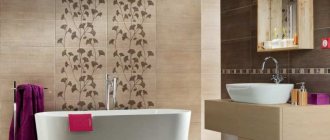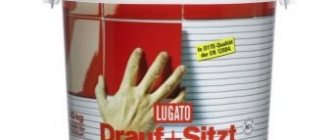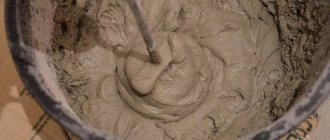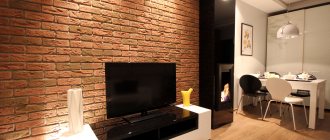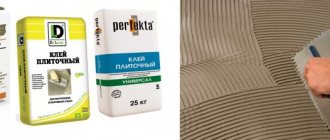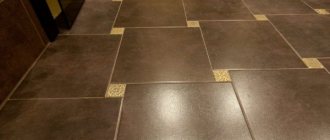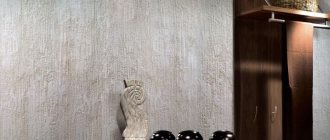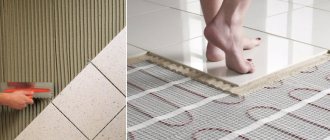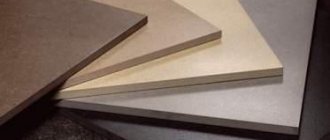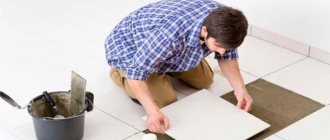Criteria for choosing adhesive for tiles
The adhesive for bathroom tiles must be of high quality and reliable.
The following criteria apply:
- Increased adhesion. Tile or ceramic tiles are quite heavy, so the adhesive composition must withstand such a load.
- High-quality glue should be flexible, easy to apply and not run off the tile.
- The adhesive composition should spread over the tile, filling cracks and irregularities.
- The longer the composition dries, the greater the chance of correcting the tile. Working with adhesives that dry quickly is inconvenient and impractical.
It is also important to use only those compounds that are not afraid of excessive humidity.
Vote
What would you choose or recommend?
Knauf Fliesen Plus
50.00 % ( 1 )
Bergauf Mosaik
0.00 % ( 0 )
Ceresit CM 14
50.00 % ( 1 )
Unis 2000
0.00 % ( 0 )
Litokol Litoplus K55
0.00 % ( 0 )
Ceresit CM 11 PLUS
0.00 % ( 0 )
Founds Mastplix T-12
0.00 % ( 0 )
Litokol X11
0.00 % ( 0 )
Volma Interior
0.00 % ( 0 )
Types of tile adhesive
There are three common types of glue, which differ in composition.
- Cement glue. It is based on cement and is presented in the form of various mixtures with different percentages of additives. There are universal compositions used for all types of tiles.
- Epoxy adhesive. With a mineral filler, with a thin composition and viscous, three different types. Used in difficult cases when tiles need to be glued to wood or metal.
- Dispersion glue. Used for plasterboard walls, it has increased adhesion and is sold in ready-made form.
Rules for choosing tile adhesive
- Scope of use. We use glue intended for indoor work, a universal version, as well as frost-resistant compounds;
- Type and size of tiles. There are separate types of adhesives for tiles made of ceramics, glass, natural stone, and so on;
- Base type. There are compositions that are designed for drywall, wood, concrete and complex surfaces;
- Operational features. For rooms with high humidity levels, standard adhesives and adhesives for underfloor heating;
Most often, you can read information on the packaging about what type of tile a particular adhesive is intended for.
An adhesive composition with increased adhesiveness is recommended for porcelain stoneware and complex vertical bases. For floor tiles, you need to use a moisture-resistant and durable adhesive based on cement.
For translucent mosaics, white glue is used, which does not spoil its appearance, unlike cement composition. The larger and heavier the tile, the stronger and more reliable the glue should be.
Preparatory work
When using adhesive for floor tiles, you need to know how to work with it. Thanks to skillful work, gluing PVC tiles to the floor will not create difficulties.
To begin work, you need to prepare the base, dilute the glue with water, determine the location of the starting point of work:
- Preparing the subfloor involves correcting it if there are any unevenness and clearing it of debris or dust. Concrete floors can be easily corrected for unevenness using plaster or concrete mortar. A wooden floor will have to be welded together or a base made of plywood or plasterboard should be laid.
- The final stage of floor preparation is to use a vacuum cleaner. It is necessary to clean the surface from dirt and dust.
- After completing this work, you need to prime the base, preferably 2 times. The primer dries quickly and after the second layer has dried, you can begin laying the material. For greater adhesion, the surface can be sanded a little.
- Dry glue, before laying the tiles, must be diluted with water in the proportions indicated on the package with the mixture. Most often, water is required from 200 to 250 mm. The water should be cold and clean.
- The liquid composition does not require preparation.
- Determining where to start work is very important, since appearance is an important indicator. The tiles are laid out in such a way that the floor pattern is not disturbed. They begin to lay out plain material so that the supposed scraps go to the opposite wall of the entrance.
Tips for choosing tile adhesive
You need to pay attention to the dimensional qualities and density of the tiles. The density of the tile determines how its cladding will absorb the composition.
- For the floor, choose a high-strength cement adhesive, with which you can level the base. Wall adhesive should not be too fluid to prevent the tiles from slipping.
- Beneficial fungicidal and antiseptic properties prevent the development of microorganisms.
- If the tiles are laid on a heated floor, it is necessary to use an adhesive that can withstand temperature changes.
- Ease of installation. This includes the drying time of the glue and the period of readiness for application from the moment of mixing.
Tool selection
An important point will be choosing the right tool. The right tool will ensure a certain ease of masonry and optimal glue consumption. In addition to buckets and a drill with a “mixer” attachment, you will need spatulas to mix the composition.
You need 2 types of them: smooth and with a jagged edge.
A smooth spatula is used to spread the adhesive mixture onto the jagged type of tool.
The notched trowel is subject to size requirements for tiles:
- If the tile used has a size of 30 by 30, use a spatula with 8 mm teeth.
- Tiles 15 by 15 cm require the use of a trowel with 6 mm teeth.
Small tile sizes require a smaller trowel. This way the optimal adhesive layer is adjusted. If you are laying tiles of different sizes, then it is advisable to use different spatulas.
Types of tile adhesive
The adhesive solution for laying tiles is mixed using an electric drill or a construction mixer. Dry powder is combined with water in the proportions specified by the manufacturer.
The solution must be thoroughly mixed, it must be homogeneous and free of lumps.
The glue should not be excessively thick or liquid; apply the solution using a special spatula with jagged edges. When gluing the tiles, you should not put too much pressure on them, as cracks may appear on them.
Cement tile adhesive
This is the most popular type, which is produced as a dry powder.
It has the following advantages:
- It is resistant to moisture even without the addition of special additives.
- Adheses well to the surface.
- Excellent adhesiveness to building materials.
- There are no toxic substances in the cement adhesive.
- Affordable price.
- Convenient installation and dismantling.
- Versatility. Cement adhesive is used for floors and walls.
The disadvantages include a long drying time, which ranges from twelve hours to a day. The adhesive is dark gray in color, so it should not be chosen for translucent transparent materials.
Epoxy Tile Adhesive
This adhesive solution is based on epoxy resin. It also has many advantages, which include the following characteristics.
- Increased level of elasticity, which allows you to lay tiles even on uneven or moving surfaces.
- Excellent adhesiveness.
- Moisture resistant. This type of glue is most often chosen for bathhouses and saunas, as well as for swimming pools.
- Resistant to temperature changes.
Working with epoxy glue is very easy and convenient; it does not stain the surface, but it is more expensive than cement glue.
When mixing the solution, it is important to strictly observe the proportions, otherwise the adhesive composition will not be correct and will not perform its functions.
Dispersion adhesive for tiles
This glue is based on synthetic acrylic resins with different polymers. This glue is produced in ready-made paste or mastic form.
Its advantages include:
- High level of elasticity.
- Moisture resistant.
- Excellent adhesion to various materials.
- Very economical consumption.
- Adhesion to the base occurs very quickly.
- Fast hardening.
What is the best way to lay tiles?
Previously, such a question did not arise - what is the best way to lay tiles. Everyone used a cement-sand mixture for this. This is quite durable, but not always appropriate and convenient material. This solution provides clear adhesion, but requires a long drying time, which leads to premature sliding of the tiles from the vertical, and in addition, its technical characteristics do not allow lengthy preparatory work to be done. In particular, it releases liquid into the supporting base and the ceramic itself and they have to be pre-treated with water to prevent this from happening, and is also subject to slight shrinkage upon drying, which requires skillful leveling of the material.
Meanwhile, the adhesive mixture does not require such work; after applying it and priming the surface, you can immediately glue the tiles.
The best adhesives
- Ceresite. A very well-known brand that offers high-quality glue. It is important not to run into a fake, so when purchasing you need to ask for a quality certificate.
- Eunice. An excellent moisture-resistant adhesive that is resistant to temperature changes.
- Knauf.
- Typhoon.
- Litokol.
Each of these manufacturers offers good tile adhesives, which have their own advantages and features of use.
Price
Prices for mixtures vary - from 250 rubles per 25 kg to, on average, 1500. Many people believe that the better, the more expensive, but in fact, the high cost does not at all indicate which adhesive for tiles is better, but may only be premium for a brand name.
To avoid overpaying, you can simply compare the technical characteristics of an expensive product with an average-priced product in the store and, having made sure that they are approximately equal, you do not need to worry that the selected mixture is somehow worse than a more expensive brand.
